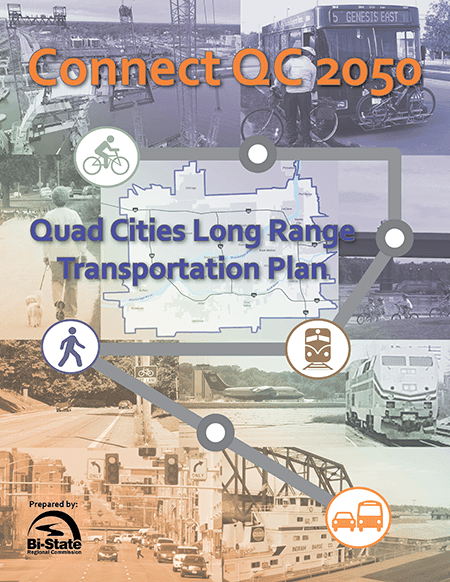The Quad Cities Metro LRTP (Long Range Transportation Plan) serves a variety of purposes: to move forward the regional vision, to guide future project development, and to identify needs for coordination and cooperation related to our transportation network. The plan identifies future travel demand and freight needs. It also looks at the current transportation system's ability to meet these demands and identifies what improvements will be needed to address future demand. As projects are identified, they are then directed through the short-range planning and programming process to ultimate implementation or construction.
2050 Plan
The plan was adopted on March 24, 2021 by Bi-State Regional Commission meeting. The 2050 plan uses a base-year of 2015 and outlines transportation improvements anticipated through the horizon-years of 2030 and 2050. The benefit of updating a plan every five years is the opportunity to either maintain course on larger long-term projects, refine our direction on other projects, or take a new course due to changes in the metropolitan area, funding resources, or technology innovations. The plan's underlying theme is progress, innovation, and connectivity as our Quad Cities Region moves transportation plans into reality.
A summary presentation of the plan provides an overview below as part of the plan adoption process. After adoption, Bi-State staff begins to prepare for the next five-year plan update. Staff collaborates with local and state governments to transition projects identified in the plan from the concept stage to implementation, taking into account local and state priorities as well as funding availability.
2055 Plan Update
The Quad Cities MPO Long Range Transportation Plan is updated on a five-year cycle. Work to update the plan is underway. From a base year of 2023, the plan considers the horizon years of 2035 and 2055. Between December 2024 and March 2026, Bi-State Regional Commission will prepare plan updates and present information to the Quad Cities MPO Technical and Policy Committees. Public involvement will occur during that process. This webpage will be site for updates, media releases and other opportunities for public involvement.
Quad Cities Travel Demand Model – What Is This and What Does it Do
Travel Demand modeling is a key tool in our LRTP process. It incorporates historical trends, local land use, travel characteristics and roadway system in our region for today and in the future. It analyzes how many trips, where to/from, what mode and which route for the entire region to help better decision making in transportation planning. The video below was developed by Iowa DOT to highlight this planning tool.
